1.08.2011
Wie das indische Fernsehen berichtete, will die indische Raumfahrt-Organisation ISRO für zukünftige Satelliten-Starts ein unbemanntes Space-Shuttle einsetzen um die Startkosten zu reduzieren.
Hier ein Blick auf den Prototyp von ISRO:
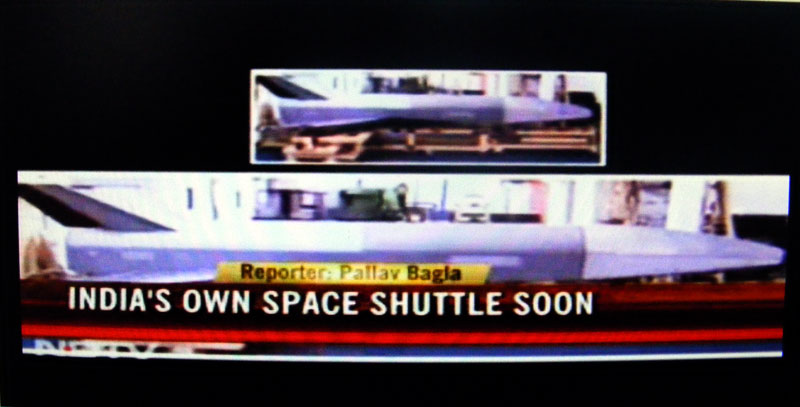
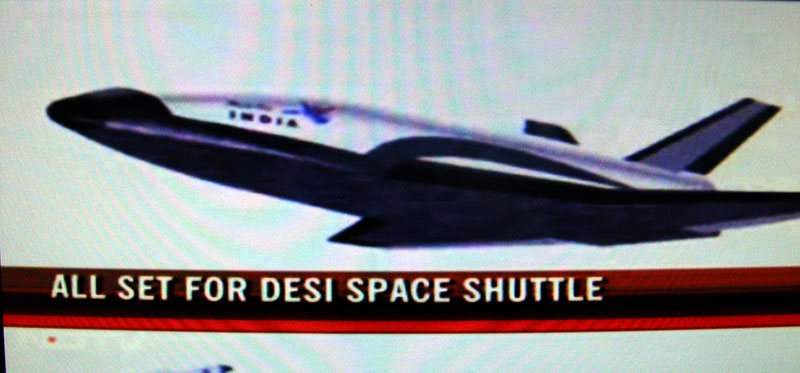
Quelle: NDTV
.
Update: 5.01.2015
.
Isro to carry out winged-reusable rocket tech demo
Isro will carry out the technology demonstration of the reusable launch vehicle in March
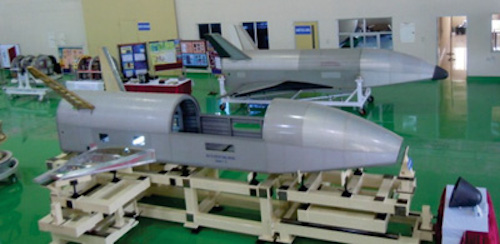
Mumbai: Satellites are typically deployed by expensive rockets which disintegrate in phases en route to space; however, the Indian Space Research Organisation (Isro) is working on developing the technology for a winged rocket that can be used repeatedly, a senior official said. Isro will carry out the technology demonstration of the reusable launch vehicle in March, the official said. Space vehicles are costly to build and launch, and making them reusable could help reduce space mission costs. “The structure that makes a rocket has to be such that it should have 98% propellant and 2% structure. Only then reusability is possible. Today’s technology does not allow you to go to that level as 5% to 10% will be the mass of the structure and around 90% will be the propellant,” said S. Somanath, associate director of Isro’s Vikram Sarabhai Space Centre (VSSC). “But then, new ideas are coming up, SpaceX is working on a reusable launch vehicle, but nobody is sure if in the next 10 years, reusable vehicles will be a reality,” Somanth added. VSSC is trying to develop a Winged Reusable Launch Vehicle Technology Demonstrator (RLV-TD) which will act as a flying tester to assess hypersonic flight, autonomous landing, powered cruise flight and hypersonic flight using air-breathing propulsion. Isro is currently integrating the flight model. In the technology demonstrator, Isro will test if the 12-tonne vehicle can reach five times the speed of sound, whether it can re-enter the atmosphere and land on the sea using its computer system. To be sure, this will be a technological demonstration and the tested vehicle will not be reusable. The VSSC director explained that take-off will be vertical like a rocket, and landing will be like that of an aircraft. “The reusable launch vehicle is important because space orbiting currently costs us $5,000 per km. That kind of money, space exploration and commercial space activities, are not possible,” explained Somanth. “We want to come down to $500, and the one problem here is hardware. Propellant is not that costly, but the hardware is extremely costly and needs to be reused for space travel to be affordable,” he added. Attempts at developing an operational reusable rocket launcher have not been quite successful so far. Till now, only two vehicles have come close to being a reusable launch vehicle—one being the space shuttle developed by the US, and the other, Buran developed by Russia. Both of these were only partially usable.
.
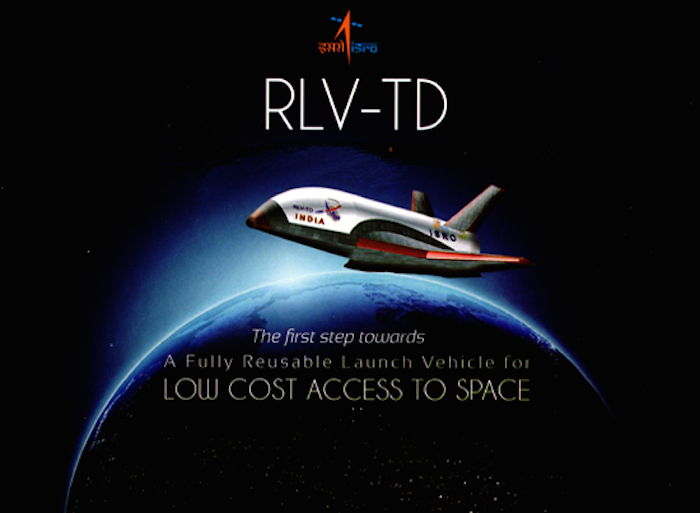
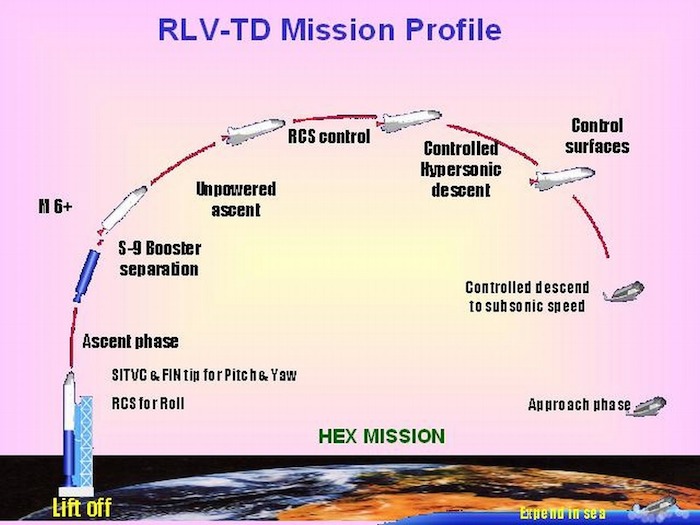
Quelle: livemint
.
Update: 27.02.2015
-
ISRO Plans to Test-fly Reusable Launch Vehicle by Mid-2015
KOVALAM: Taking India’s ‘space shuttle’ dreams a notch closer to reality, the Indian Space Research Organisation (ISRO) plans to test-fly the Re-usable Launch Vehicle-Technology Demonstrator (RLV-TD) by the middle of 2015.
“The test-flight will take place either by the end of the first half of this year or the beginning of the second half. Work is progressing satisfactorily,” ISRO’s new chief A S Kiran Kumar told Express on the sidelines of the three-day International Conference on Climate Change and Disaster Management which began here on Thursday. “This first test is one of a segment. Work on the RLV is progressing in steps,” he said.
he unmanned, sub-orbital mission will lift off from the second launch pad of the Satish Dhawan Space Centre (SDSC), Sriharikota. In simple terms, the two-stage technology demonstrator is a ‘space plane’ rigged atop a rocket. “The first stage burns on solid fuel. Atop it is the space plane which will return to earth after the flight,” Kiran Kumar said.
At present, for placing satellites in orbit, ISRO uses the Polar Satellite Launch Vehicle (PSLV) and the Geosynchronous Satellite Launch Vehicle (GSLV), both expendable vehicles. A Re-usable Launch Vehicle (RLV) - think NASA’s space shuttles - will bring down expenses phenomenally and is the next big leap in ISRO’s launch vehicle programme.
Kiran Kumar, who took over as ISRO chairman in January this year, also listed his other priorities for the space agency. Increasing the number of missions, completing India’s navigational satellite constellation and the big cryogenic engine for the Mk-III version of GSLV are a few.
“We have to streamline the whole process. We are actually behind schedule in many programmes,” he said. An important project underway is the development of the semi-cryogenic engine, which, again slashes launch costs remarkably. Whereas a cryogenic engine uses Liquid Hydrogen (LH2) and Liquid Oxygen (LOX) as propellants, a semi-cryogenic system replaces LH2 with cheaper and easier-to-handle kerosene.
Quelle: THE NEW INDIAN EXPRESS
.
Update: 5.03.2015
.
ISRO to launch a test flight of reusable launch vehicle during April-June
NEW DELHI: The Indian Space Research Organisation (ISRO) will carry out a test flight of Reusable Launch Vehicle - Technology Demonstrator (RLV-TD) any day between April-June this year.
The reusable vehicle will bring down the cost of satellite launches substantially in future, making such operations quite competitive in global commercial launch market.
"Technology Demonstrator winged body vehicle weighing 1.5T will be lofted to a height of 70 km using solid booster, thus attaining five times the speed of sound. Thereafter, it will descend by gliding and splashing down into the sea", said an official statement.
This test flight would demonstrate the Hypersonic aerodynamics characteristics, Avionics system, Thermal protection system, Control system and Mission management.
"Development of Reusable Launch Vehicles is a technical challenge and it involves development of many cutting edge technologies. The magnitude of cost reduction depends on development and realization of fully reusable launch vehicle and its degree of reusability", said the statement issued on Wednesday.
The ISRO has taken steps to develop next generation launch vehicle GSLV MkIII, capable of launching four ton class communication satellites to Geo-synchronous Transfer Orbit, which would bring down the cost of satellite launches.
Besides, the ISRO is setting up Indian Regional Navigation Satellite System (IRNSS) to provide positioning and navigational services in Indian mainland and surrounding region up to 1,500km.
The IRNSS consists of seven satellites in a constellation, three satellites in geostationary orbit and four satellites in geosynchronous orbit. The objective of IRNSS is to provide positioning services over Indian region with an absolute position accuracy of better than 20 metres.
"The IRNSS provides two services namely Standard Positioning Service (SPS) for Civilian users and Restricted Service (RS) for strategic users", said the statement.
Out of the seven satellites required in the constellation, three satellites namely, IRNSS-1A, 1B & 1C have already been successfully placed in the orbit.
The fourth satellite IRNSS-1D is scheduled for launch during March 2015.
The work on remaining three satellites is in progress.
"The associated ground segment for maintaining the satellites in orbit, monitoring the constellation status, correction of the orbital parameters and navigation data uploading is in place", said the statement.
Quelle: The Times of India
-
Update: 15.05.2015
.
Isro to assemble key vehicle for human spaceflight
BENGALURU: The Indian Space Research Organisation (Isro) is inching closer towards its Human Space Mission. It is test launching a version of its Reusable Launch Vehicle Technology Demonstrator (RLV-TD) later this year, following a successful test of the crew module last year.
The agency has already transported and positioned boosters for the launch expected in second half of this year. It will begin assembling the vehicle in 8-10 weeks.
"The launch was to happen sometime in mid-2015, but there's been a delay as we decided to complete our commercial launches first," a senior Isro official said. With the crew module recovery tests done, the next crucial test will be to test the RLV-TD for the Hypersonic Experiment Mission-01 (HEX-01).
"As with the crew module test, there'll be no people aboard this vehicle. We will test the technology, which has been worked upon for over half-a-decade," an Isro spokesperson said.
The UPA-led government had sanctioned Rs 145 crore for the Human Space Mission. The RLV-TD is a major step towards realising this programme, mooted to begin in 2017. The objective is to carry a two-member crew to Low Earth Orbit and return them safely. The winged RLV-TD has been configured to act as a flying test bed to evaluate various technologies like hypersonic flight, autonomous landing, powered cruise flight and flight using air breathing propulsion.
As part of the pre-project activities, Isro is focusing on the development of critical technologies for subsystems such as Crew Module, Environmental control and Life Support System, Crew Escape System and so on. Many of these are already complete. Eventually, Isro will have to use the GSLV platform, which is yet to completely gain the confidence of the agency.
Quelle: The Times of India
.
Update: 20.05.2015
.
Futuristic Unmanned Space Shuttle Getting Final Touches
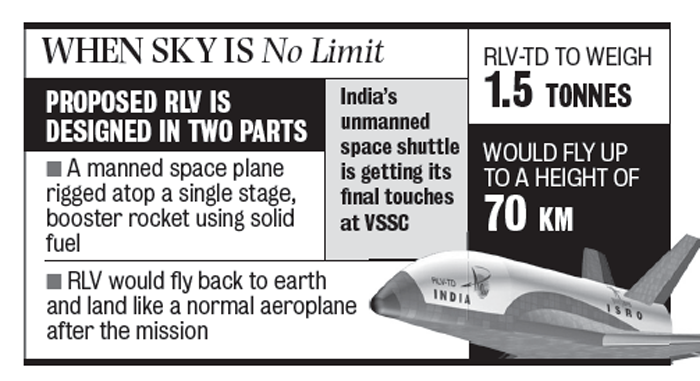
THIRUVANANTHAPURAM: A scaled-down, unmanned version of India’s futuristic space shuttle is getting the final touches at the Vikram Sarabhai Space Centre (VSSC) in Thumba.
With the construction of the Reusable Launch Vehicle-Technology Demonstrator (RLV-TD) nearing completion, A S Kiran Kumar, chairman, Indian Space Research Organisation (ISRO), is scheduled to lead a review of the dream project here on Friday.“The ‘space plane’ part of the RLV-TD is almost ready. We are now in the process of affixing special tiles on its outer surface which is needed for withstanding the intense heat during re-entry into the earth’s atmosphere,” SSC director M Chandradathan said.
“The entire construction of the RLV-TD is being handled by VSSC,” he said.
ISRO has tentatively slated the prototype’s test flight from the first launchpad of Sriharikota spaceport for July this year, but the date would be finalised depending on the completion of construction. The proposed RLV is designed in two parts; a manned space plane rigged atop a single stage, booster rocket using solid fuel. The rocket is expendable while the RLV would fly back to earth and land like a normal aeroplane after the mission.
The prototype- ‘the RLV-TD’ weighs just 1.5 tonnes and would fly up to a height of 70 kms.
For the test mission, the unmanned space plane part would glide into the Bay of Bengal a la the recent crew module successfully tested aboard the Geosynchronous Satellite Launch Vehicle Mk-III (GSLV Mk-III) experimental flight last year.India’s answer to the space shuttle, the RLV is one of the big steps forward in ISRO’s launch vehicle programme along with the GSLV Mk-III and the Unified Launch Vehicle project.
ISRO has successfully tested re-entry technology twice- the first time in 2009 with the Space Capsule Recovery Experiment-1 (SRE-1) in January 2007 and the second with the Crew Module Atmospheric Re-entry Experiment (CARE) aboard the GSLV Mk-III in December 2014.
Quelle: THE INDIAN EXPRESS
-
Update: 30.05.2015
.
Erster RLV-Testflug mit Hyperschall-Flugexperiment für August geplant
The Indian Space Research Organisation is gearing up for the first test flight of the fully Reusable Launch Vehicle (RLV), under plans to drive down the cost of placing satellites in orbit.
The test flight of the indigenously developed RLV- TD (Technology Demonstrator) will take place in late July or early August after the launch of the PSLV- C28 from Sriharikota, outgoing Director, Vikram Sarabhai Space Centre (VSSC) M.C. Dathan told the media here on Friday. RLV has been conceived by ISRO as a space plane that will cut the launch cost from the present level of $5,000 per kg to $ 500 per kg.
The first trial involves the hypersonic flight experiment during which the RLV resembling a small winged aircraft will be launched up to an altitude of 70 km from atop a solid booster rocket and released. The thermally insulated RLV will re-enter the atmosphere and travel back to earth in a controlled descent, to be recovered from the sea, explained S. Somanath, Director-designate, Liquid Propulsion Systems Centre (LPSC).
4-km runway
Mr. Dathan said the development of RLV was in the final stages. He said a 4 km runway would be constructed at SHAR for the RLV to make a horizontal landing in the subsequent test flights.
Mr. Somanath added that the RLV would be eventually powered by an air breathing scramjet under development. The first prototype of the scramjet with a 10 kg thrust was due to be tested in one month, followed by the development of a test facility at Mahendragiri for a more powerful engine.
Quelle: The Hindu-
Update: 13.10.2015
.
Wiederverwendbare RLVTD Trägerraketen Test in nächstes Jahr wegen kommerzieller Raketenstarts verschoben
BENGALURU: Indian Space Research Organisation (Isro) has postponed the test launch of the key reusable launch vehicle technology demonstrator (RLVTD) to next year.
While the earlier test schedule of September was disrupted by the launch of Astrosat, India's first astronomy satellite other launches with societal application have delayed it further.
A source said the focus currently is on putting the payload for GPS Aided Geo Augmented Navigation (GAGAN) system which will be put in space by GSAT in November first week and the subsequent Indian Regional Navigation Satellite System (IRNSS) launch in December.
"Both these missions have direct societal applications, which Isro feels is important," the source said, reiterating that preparations for the RLVTD test were all ready. The reusable launch vehicle will reduce launching cost to one-tenth of what's incurred now.
Another source pointed out that even the eventual test of the RLVTD will be of a vehicle that's one fifth the original prototype and may not even require the PSLV. "A single-phase rocket will suffice," he said. Isro has already successfully completed testing the crew module, which is important for the human space programme.
Quelle: THE TIMES OF INDIA
.
Update: 29.12.2015
.
ISRO's RLV-TD Project Likely to be Delayed
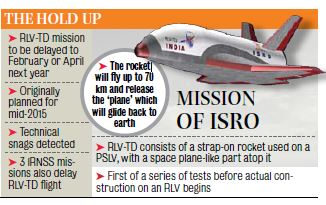
THIRUVANANTHAPURAM: Technical snags have forced the Indian Space Research Organisation (ISRO) to put off the first test on a scaled-down prototype of India’s futuristic space shuttle.
Sources said on Sunday that the Reusable Launch Vehicle-Technology Demonstrator (RLV-TD), under development at the Vikram Sarabhai Space Centre (VSSC) here at Thumba, developed a minor leak during a test, forcing the ISRO to postpone the mission. The ambitious RLV-TD, the first small step to building a ‘space shuttle’ which can return to earth after accomplishing space missions, is likely to be delayed up to April 2016. ISRO had originally planned a mid-2015 launch for the RLV-TD. It had later been postponed to January 2016.
VSSC Director Dr K Sivan said that some of the components had to be re-assembled. ‘’If things go as planned, we can launch the mission in the first week of February. Otherwise, the test will be conducted in the first week of April,’’ he said. ISRO has three missions lined up for January and March, which is another reason why the RLV-TD could be delayed up to April. ISRO plans to launch the three remaining IRNSS satellites - which will complete the seven-satellite Indian Regional Navigational Satellite System - by March 31. The first of the three is to be launched on January 20, and the remaining two in March using the Polar Satellite Launch Vehicle (PSLV). “The missions will be launched from the first launch pad, which is also to be used for the RLV-TD,’’ Sivan said.
The RLV-TD consists of a winged space plane-like part rigged atop a booster rocket. The rocket will go up to a height of 70 km and release the space plane portion which will glide down to earth.
In the first test, the space plane will glide into a landing in the Bay of Bengal. RLV-TD will be the first of a series of tests planned by ISRO before venturing to build the actual vehicle.
Quelle: THE INDIAN EXPRESS
-
Update: 29.03.2016
.
RLV-TD Likely to Touch Record Mach 5 Speeds: ISRO Officials
-
THIRUVANANTHAPURAM: The Reusable Launch Vehicle-Technology Demonstrator (RLV-TD), whose launch is planned for May this year, will also be the first Indian ‘aircraft structure’ to fly up to Mach 5 speeds, according to ISRO officials. To compare, the Light Combat Aircraft (LCA) touches a maximum speed of Mach 1.6.
The RLV-TD is essentially ISRO’s first “baby step” towards building a workable RLV, which will bring down launch expenses phenomenally. The 1.75 tonne, 6.5 metre-long model is due to leave the Vikram Sarabhai Space Centre (VSSC) here at Thumba in a week’s time for Sriharikota spaceport via Bangalore.
In fact, the aircraft-shaped technology demonstrator will achieve Mach 5 speeds twice, during ascent atop a booster rocket and amid final descent after separation from it from a height of 70 kms.
“It is actually designed to achieve Mach 6 speeds,” sources said. The `95-crore mission is the first of a series of technology demonstrations ISRO is planning to conduct before actually designing and building an advanced RLV, which is expected to materialise by 2030. “Acoustic tests will be conducted at Bangalore before the RLV-TD is taken to Sriharikota,” VSSC director K Sivan said.
Shaped like a tiny aircraft, with double delta wings and twin fins, the technology demonstrator is one-fifth the size of the actual vehicle planned. It will be taken up to 70 kms by a booster rocket and separated at that height to glide back to earth. The vehicle will land in the Bay of Bengal, some 560 kms from Sriharikota. ISRO officials said that, unlike the earlier SRE-1 and Crew Module Atmospheric Re-entry Experiment missions, the RLV-TD will not be recovered from the sea.
Quelle: The Indian Express
-
Update: 25.04.2016
.
Isro to Test Reusable Launch Vehicle in June
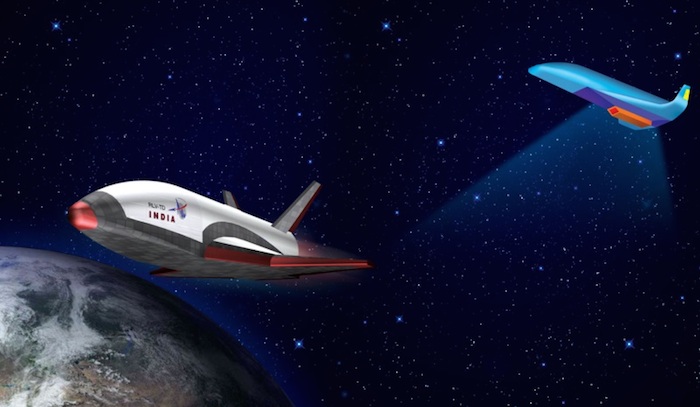
India is set to flight test, in June, a home-grown reusable launch vehicle to demonstrate its capability to re-enter atmosphere and return to earth for more space missions, a top official said on Saturday.
"The winged vehicle, in the shape of an aircraft, is on way to Sriharikota for the maiden flight test in June from our spaceport there," Indian Space Research Organisation (Isro) chairman A.S. Kiran Kumar said at an Indian Air Force event Bengaluru.
Sriharikota in coastal Andhra Pradesh, is about 80km northeast of Chennai.
As the cost of access to space exploration and utilisation is expensive, the space agency has developed the two-stage-to-orbit reusable vehicle (RLV-TD) for reducing the cost of launching its future satellites.
It has completed various tests, including acoustics at the National Aerospace Laboratories (NAL) here to act as a flying test bed to evaluate its technologies such as hypersonic flight, autonomous landing, and powered cruise flight, using air-breathing propulsion.
"The vehicle will be flown up to 70 km and released for its re-entry into the atmosphere. It has to withstand the atmospheric pressure and heat friction while re-entering into the atmosphere," Kiran Kumar said at the ninth annual Air Chief Marshal L.M. Khatre lecture.
The space agency will develop the RLV technologies through hypersonic flight experiment, landing experiment, return flight experiment and scramjet propulsion experiment.
"As the prototype vehicle is one-sixth of the original size, it may not require our polar satellite launch vehicle (PSLV)," the Isro chief added.
The space agency is also working on the second version of the geosynchronous satellite launch vehicle (GSLV Mark-III) to carry four-tonne class satellites into the geostationary orbit, about 36,000 km above earth.
The first experimental flight of the heavy rocket was carried on December 18, 2014 to test its atmospheric phase.
Quelle: Gadgets360
Update: 15.05.2016
.
ISRO embarks on launching Indian space shuttle
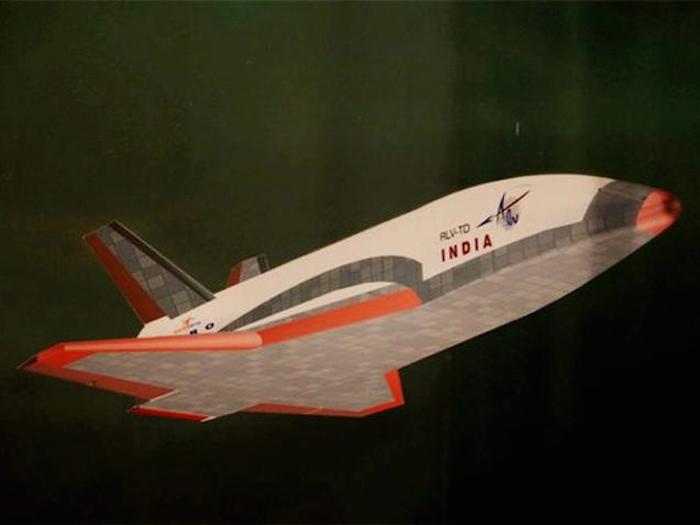
Scientists at ISRO believe that they could reduce the cost by as much as 10 times if reusable technology succeeds
Indian Space Research Organisation (ISRO) is all set to undertake the maiden launch of its ‘space shuttle’, a fully made-in-India effort. A sleek winged body, almost the weight and the size of sports utility vehicle (SUV), is being given final touches at Sriharikota where it awaiting final countdown.
Here's what we know:
» India’s space port at Sriharikota on the coast of the Bay of Bengal in Andhra Pradesh will witness the launch of the indigenously made Reusable Launch Vehicle-Technology Demonstrator (RLV-TD). After the launch, it will be glide back onto a virtual runway in the Bay of Bengal.
» The RLV-TD is unlikely to be recovered from sea during this experiment as it is expected that the vehicle will disintegrate on impact with water since it is not designed to float.
» The purpose of the experiment is to help the shuttle glide over a virtual runway in the Bay of Bengal, situated 500 km from the coast.
» India’s frugal engineers believe the solution to reducing cost of launching satellites into orbit is to recycle the rocket or make it reusable.
» Scientists at ISRO believe that they could reduce the cost by as much as 10 times if reusable technology succeeds, bringing it down to $2,000 per kg.
» K. Sivan, director of the Vikram Sarabhai Space Centre, Thiruvananthapuram, says, “These are just the first baby steps towards the big Hanuman leap.”
» The final version will take at least 10-15 years to get ready.
» The special booster or the first stage is powered using a solid fuel and it will hoist the RLV-TD prototype to about 70 km into the atmosphere from where the descent will begin.
» During the descent phase, small thrusters will help the vehicle navigate itself to the landing area.
» The making of the Indian space shuttle or RLV-TD has taken five years and the government has invested Rs. 95 crore in the project. This flight will test the capability of the vehicle to survive a re-entry at speeds higher than that of sound.
Quelle: The Hindu
---
ISRO Embarks On Launching Indian Space Shuttle
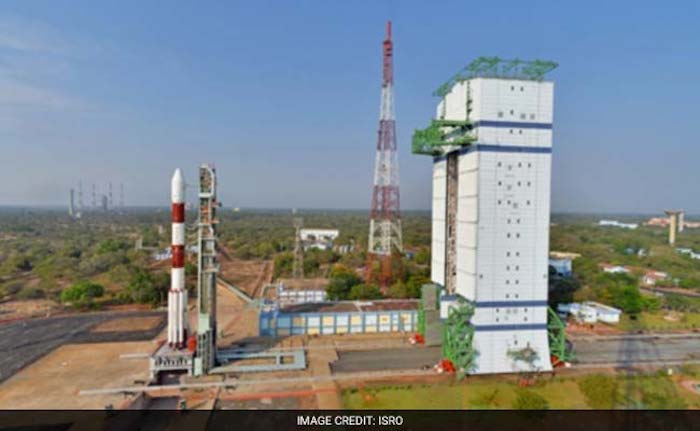
ISRO is set to undertake the maiden launch of its very own indigenous version of a 'space shuttle'. (File Photo)
-
THIRUVANANTHAPURAM:
Indian Space Research Organisation (ISRO) will embark this month on a never before space flight that would make history.
The Indian space agency is set to undertake the maiden launch of its very own indigenous version of a 'space shuttle', a made-in-India effort.
Today, a sleek winged body almost the weight and size of a sports utility vehicle (SUV) is being given final touches at Sriharikota, awaiting the final countdown.
Scientists at ISRO believe that they could reduce the cost of launching stuff into space by as much as 10 times if reusable technology succeeds, bringing it down to USD 2,000 per kg.
Very soon and if all goes well possibly before the monsoon sets in, India's space port at Sriharikota on the coast of the Bay of Bengal in Andhra Pradesh will witness the launch of the indigenously made Reusable Launch Vehicle - Technology Demonstrator (RLV-TD). This will be the first time ISRO will launch a spacecraft, which has delta wings. After launch, it will be glided back onto a virtual runway in the Bay of Bengal.
The RLV-TD is unlikely to be recovered from sea during this experiment as it is expected that the vehicle will disintegrate on impact with water since it is not designed to float. The purpose of the experiment is not to see it float but to glide and navigate from a velocity five times higher than the speed of sound onto a designated virtual runway in the Bay of Bengal some 500 km from the coast.
Similar in its looks to the American space shuttle, the RLV-TD being experimented is a scale model which is almost 6 times smaller than the final version.
K Sivan, director of the Vikram Sarabhai Space Centre, Thiruvananthapuram, says, "These are just the first baby steps towards the big Hanuman leap."
India embarked on making its own version of the space shuttle by thinking about it more than 15 years ago, but work in earnest started only five years ago when a dedicated team of engineers and scientists plunged into making RLV-TD a reality. The 6.5-m-long 'aeroplane'-like spacecraft will weigh 1.75 tons and will be hoisted into the atmosphere on a special rocket booster.
The special booster or the first stage is powered using a solid fuel and it will hoist the RLV-TD experiment to about 70 km into the atmosphere from where the descent will begin.
During the descent, phase which is essentially a glider like event small thrusters will help the vehicle to be navigated to the exact spot where it is supposed to land.
Ships, satellites and radars will monitor its descent. The current experimental version has no undercarriage so it cannot be brought back onto land and India lacks a runway that is longer than 5 km in length to accommodate such a landing.
Some private billionaires with very active support from NASA have been trying to master vertical lift-off and vertical landing as part of trying to recycle rocket engines.
SpaceX is a company owned by South Africa-born billionaire Elon Musk which became big through the Internet economy and has been able to land its Falcon-9 rocket onto a sea-based platform.
On the same lines the company Blue Origin owned by Jeff Bezos landed its New Shepard rocket on land in Texas. Bezos, another billionaire, made it big by building the Amazon online trading platform.
NASA chief General Charles Bolden recently said the competition has shifted to a fight among billionaires to reduce the cost of launching satellites into space.
The making of the Indian space shuttle or RLV-TD has taken 5 years and the government has invested Rs. 95 crore in the project. This flight will test the capability of the vehicle to survive a re-entry at speeds higher than that of sound so it is called a hyper sonic experiment (HEX).
Later, in the next few flights the RLV will be subjected to a landing experiment and another return flight experiment. Once these are successful, ISRO will then decide on what should be the final configuration of the Reusable Launch Vehicle.
One key technology the scientists at VSSC had to develop was to make materials that can withstand high temperatures that the exterior of the vehicle is faced with as it comes back into the dense atmosphere after its journey through near vacuum in space.
The friction from the air turns the exterior like a red-hot iron plate. To be able to withstand these 5000-7000 degrees Celsius temperature the scientists have developed very lightweight heat resistant silica tiles that are plastered on the underbelly of the so-called Indian space plane.
The nose cone takes the brunt of the high temperatures and is made up of a special carbon-carbon composite that can withstand high temperature. These special materials are necessary to protect the insides of the vehicle where the temperature should never go higher than 50 degrees Celsius.
It is these heat resistant tiles and thermal coating that failed on the American Space Shuttle, Columbia that resulted in the death of Indian born American astronaut Kalpana Chawla's in 2003. Consequently, ISRO has laid a lot of emphasis on the thermal management of the RLV.
After the successful deployment of the Swadeshi Global Positioning System through NAVIC or Navigation with Indian Constellation, ISRO is again reaching for the stars.
Quelle: NDTV
12141 Views
